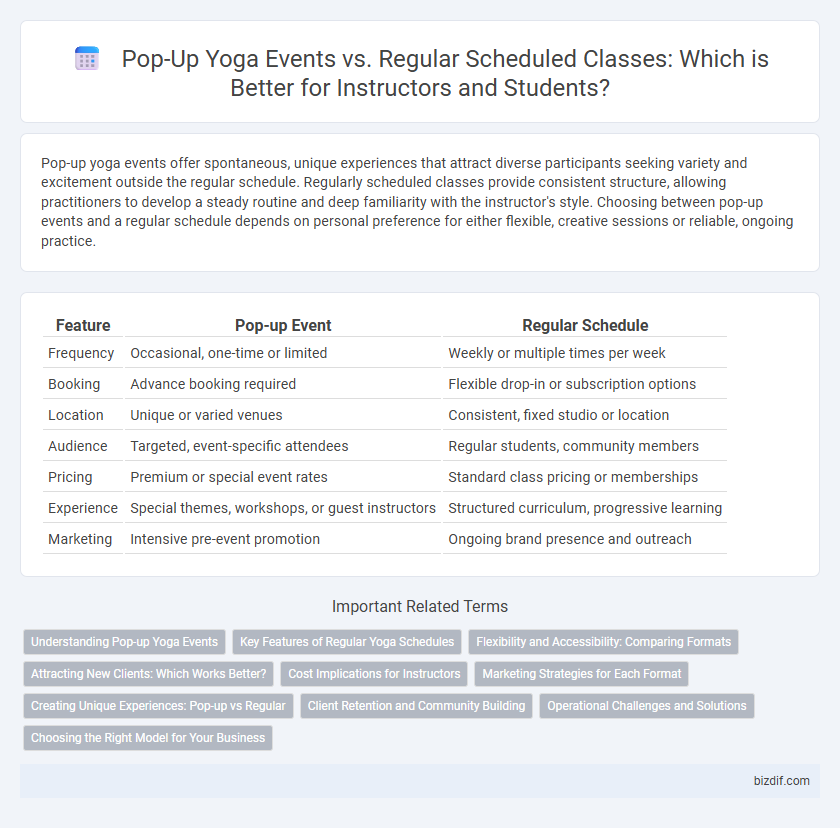Pop-up yoga events offer spontaneous, unique experiences that attract diverse participants seeking variety and excitement outside the regular schedule. Regularly scheduled classes provide consistent structure, allowing practitioners to develop a steady routine and deep familiarity with the instructor's style. Choosing between pop-up events and a regular schedule depends on personal preference for either flexible, creative sessions or reliable, ongoing practice.
Table of Comparison
| Feature | Pop-up Event | Regular Schedule |
|---|---|---|
| Frequency | Occasional, one-time or limited | Weekly or multiple times per week |
| Booking | Advance booking required | Flexible drop-in or subscription options |
| Location | Unique or varied venues | Consistent, fixed studio or location |
| Audience | Targeted, event-specific attendees | Regular students, community members |
| Pricing | Premium or special event rates | Standard class pricing or memberships |
| Experience | Special themes, workshops, or guest instructors | Structured curriculum, progressive learning |
| Marketing | Intensive pre-event promotion | Ongoing brand presence and outreach |
Understanding Pop-up Yoga Events
Pop-up yoga events offer unique, temporary experiences that differ from regular schedule classes by providing flexibility and novel environments, often held in unconventional spaces to attract diverse participants. These events emphasize spontaneity and community engagement, enhancing practitioners' connection beyond routine studio settings. Understanding pop-up yoga events highlights their role in expanding access to yoga practice and fostering social interaction within the wellness community.
Key Features of Regular Yoga Schedules
Regular yoga schedules offer consistent class timings, enabling practitioners to develop a disciplined routine and track progress effectively. They provide a structured curriculum tailored to varying skill levels, ensuring gradual improvement and sustained physical and mental benefits. Regular sessions foster a community atmosphere, enhancing motivation and support among participants.
Flexibility and Accessibility: Comparing Formats
Pop-up yoga events offer unmatched flexibility by providing sessions at varying times and unique locations, catering to spontaneous attendees and those with unpredictable schedules. Regularly scheduled classes enhance accessibility through consistent timing and familiar environments, fostering routine and commitment among practitioners. Comparing these formats highlights that pop-up events attract a diverse, casual audience while regular classes sustain long-term participation and skill development.
Attracting New Clients: Which Works Better?
Pop-up yoga events create a sense of urgency and exclusivity that can effectively attract new clients by offering a unique, one-time experience. Regularly scheduled classes build trust and consistency, encouraging long-term commitment and steady growth of the client base. Studios aiming to expand quickly may benefit from pop-up events, while those focused on sustained retention see better results with a reliable class schedule.
Cost Implications for Instructors
Pop-up yoga events often require instructors to invest in additional marketing and venue rental fees, impacting overall profitability compared to regular scheduled classes held in established studios. Regular schedules provide steady income and lower overhead costs, as venues and advertising are typically included in ongoing arrangements. Instructors must weigh the potential higher earnings from pop-up events against the financial stability offered by regular class commitments.
Marketing Strategies for Each Format
Pop-up yoga events create urgency and exclusivity, leveraging social media teasers and limited-time offers to attract spontaneous attendance and generate buzz. Regular schedule classes benefit from consistent branding, loyalty programs, and email marketing campaigns to build a steady community and encourage long-term subscriptions. Tailoring marketing strategies to each format maximizes participant engagement and revenue by aligning promotional efforts with audience behavior and event characteristics.
Creating Unique Experiences: Pop-up vs Regular
Pop-up yoga events offer spontaneous, immersive experiences in unique locations that energize participants with novelty and exclusivity, contrasting with the consistency and structured progression found in regular scheduled classes. These temporary sessions foster community engagement and attract diverse practitioners seeking fresh challenges beyond the routine studio environment. The strategic use of themed pop-ups enhances creativity and deepens practitioners' connection to the practice by integrating specialized workshops and unconventional settings.
Client Retention and Community Building
Pop-up yoga events create exclusive, immersive experiences that enhance client retention by fostering excitement and novelty. Regularly scheduled classes build stability and a reliable community foundation, encouraging consistent practice and stronger social connections. Combining both formats maximizes engagement by balancing spontaneity with routine, strengthening overall community cohesion.
Operational Challenges and Solutions
Pop-up yoga events pose operational challenges such as unpredictable attendance, limited setup time, and venue constraints, requiring flexible scheduling and modular equipment solutions. In contrast, regular schedules benefit from fixed locations and predictable class sizes, allowing for streamlined instructor planning and resource allocation. Implementing digital booking platforms and adaptive staffing models helps manage fluctuations inherent in pop-up events, enhancing participant experience and operational efficiency.
Choosing the Right Model for Your Business
Pop-up yoga events offer flexibility and attract diverse clientele through unique, limited-time experiences, ideal for testing new markets or boosting brand visibility. Regular scheduled classes establish consistent revenue streams and build a loyal community by fostering routine and deeper instructor-student connections. Evaluating your business goals, target audience, and resource capacity is essential to selecting the optimal model that balances growth potential with operational sustainability.
Pop-up Event vs Regular Schedule Infographic

 bizdif.com
bizdif.com